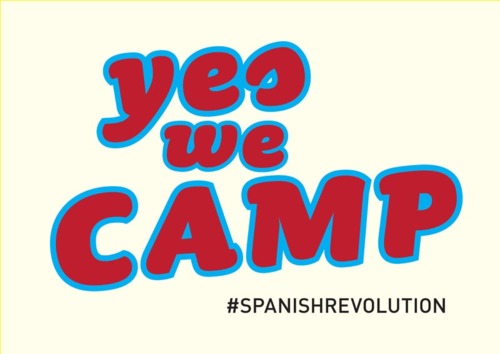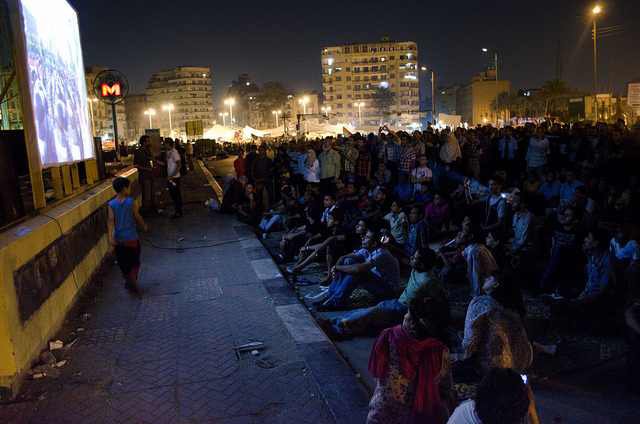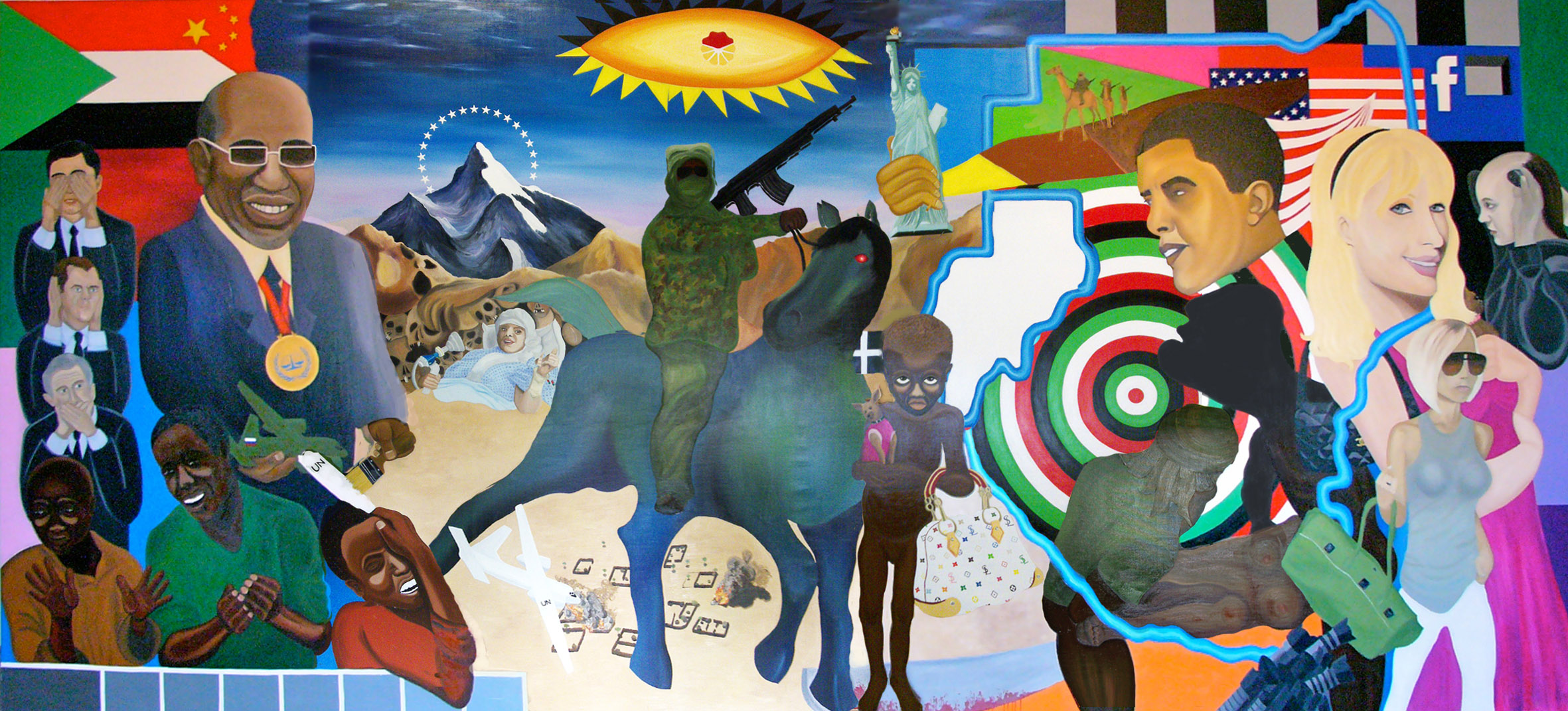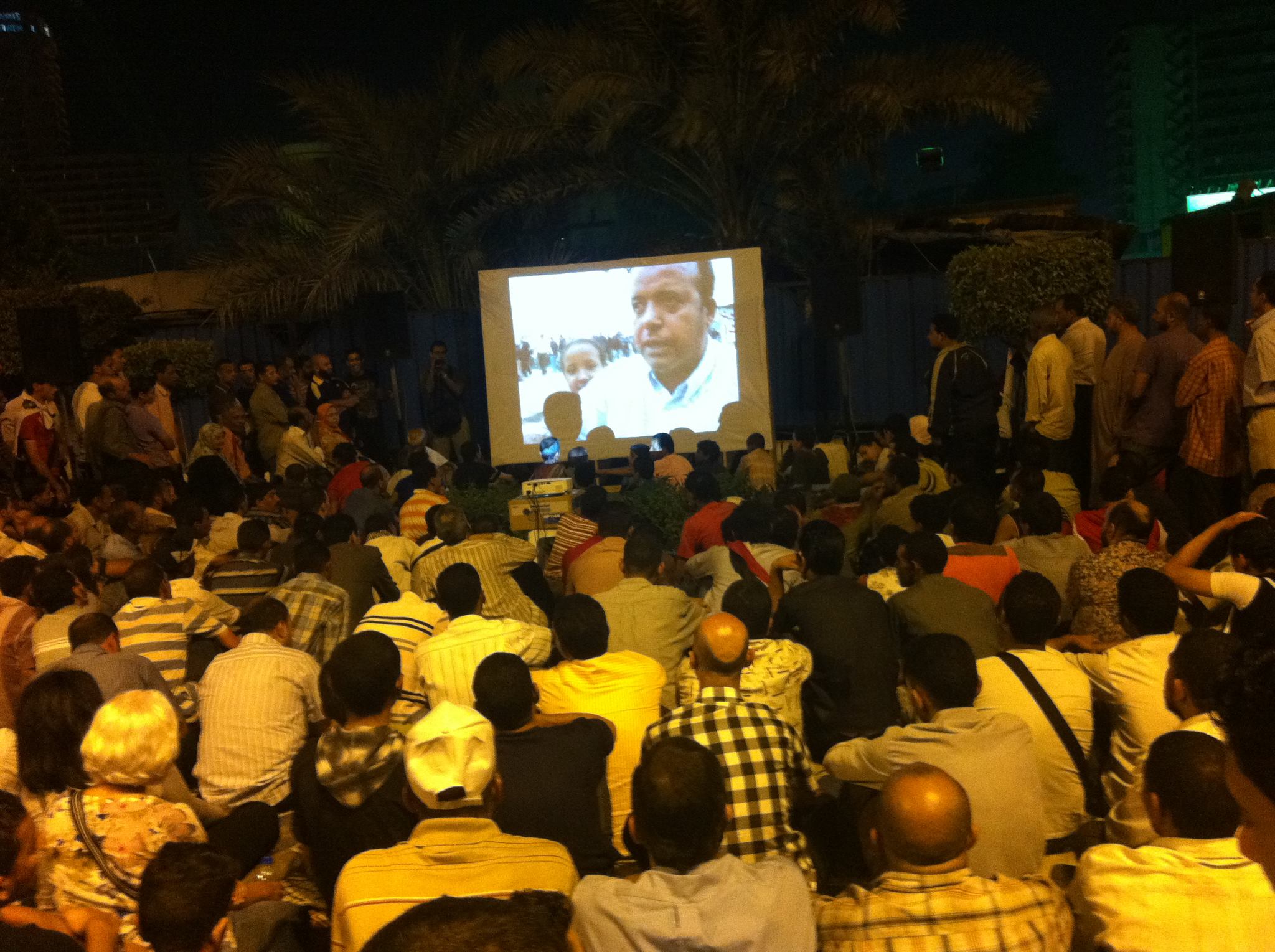Yes We Camp!
Michel de Certeau observed that the tactics employed by the ‘weak’ are always on the watch for opportunities, and that these opportunities must be seized “on the wing”. Tactics, de Certeau writes, have no base at their disposal from where they can capitalise on their advantages, prepare their expansions, or secure their independence from circumstances. Instead tactics ‘insinuate’ themselves into the places of others. They operate on the terrain of strategic power, ‘fragmentarily’, without taking it over in its entirety. Whatever these tactics win, they cannot keep. [1]
Hence, tactics are always nomadic.

The Spanish elections of 2011 certainly presented one such opportunity to appropriate the moment and a strategic space tactically. The spill-over of resentment over youth unemployment, political inaction and incompetence, and the continuing spectre of austerity sparked a spontaneous anti-movement; Los Indignados, the outraged. Los Indignados started massive street protests taking the city squares in cities all over Spain by camping on them, repurposing the strategic space for civic deliberation and protest.
Perhaps most remarkable about this ‘anti-movement’ is precisely its refusal to be or become a movement. In their Manifesto for Real Democracy they write: “We are ordinary people. We are like you: people, who get up every morning to study, work or find a job, people who have family and friends. People, who work hard every day to provide a better future for those around us.” [2] And in the call for nothing less than #Globalrevolution the initiators identify themselves as “the outraged, the anonymous, the voiceless”, who no longer gaze at vertical power, but instead look sideways, horizontally: “No political party, association or trade union represents us. Nor do we want them to, because each and every one of us speaks for her or himself.” [3]
When scrutinising the websites and resources that are connected to the central anchoring point, http://takethesquare.net/, no final set of principles or demands can be found, except for a call to involvement in working towards a ‘better world’ that puts ‘people and nature’ before ‘economic interests’, and useful documents that can guide the process of bottom-up, collective decision making, avoiding the need for leadership or ‘organisation’. “The time has come for the woman and man in the street to take back their public spaces to debate and build a new future together.” [4]
Camping Blues

An important question is where to locate your camp? The city square is for obvious reasons a well chosen site. As Greek activist Christos Gionanopoulos maintains, “democracy is born in the square“, the classical site for a people’s assembly. In his view the ‘movement of the squares’ has initiated a startlingly new political culture, one that its open, participatory, and offers a ‘directly democratic way of organising and functioning’. “Within a single week it has given birth to a political culture of a different type, one that literally overcomes all known models of organising and struggle to date“, Gionanopoulos maintains. [5]
There is a deeper sense of media awareness in this (anti-) ‘movement of the squares’. Gionanopoulos writes: “..the stance of the movement toward Mass Media is also differentiated, with the refusal to engage with them, not even by way of issuing press releases. With the screening of what part of its procedures and organising is photographed or taped, and most importantly, with the creation of the movement’s own channels of communication — with its main website www.real-democracy.gr, being the only medium-voice of its decisions.” But obviously, the well-chosen site, the public city square derives much of its power from its public visibility. It is certainly impossible, and also highly undesirable for this public spectacle not to be picked up by mass and mainstream media. In fact the public camps on city squares are one of the most mediagenic forms of popular protest to have emerged in recent years, from Tahrir to Puerta del Sol, and this status has undeniably facilitated their international dispersal by the very system the activists claim to deny.
Some activists can also get disheartened with the lagging nature of collective and non-hierarchical decision making procedures. In a text of 2002, The Dark Side of Camping, Susanne Lang and Florian Schneider reflect on the daily experience of the International border camp in Strasbourg, July 19 – 28, 2002. [6] They recall how by the time that the ‘radical-democratic decision-making process’ had come to the point of stating positions, the sun had already reached Zenith, without actual decisions having been made. The urgency of the matter on the table, the inhuman border, detention and expulsion regimes appeared to get lost in the haze of bottom-up democracy, for activists in a hurry to address them head on. Exasperation and frustration can easily set in. Thus, de-centred decision making always needs to navigate a precarious balance.

Refusal of the media question was prevalent in those days, more so than in the current ‘movement of the squares’. Lang and Schneider lament the ignorance towards the media activist component in the border camp, derided internally as ‘silicon valley’. But they also point out how the complete refusal to co-operate with any media outlet, not even the indymedia type, lead to a fatal distortion of public perception of the actions: “Clearly, the manner in which the whole event is perceived from the outside will necessarily shift if the simple attempt to mediate ones own positions will be dismissed as opportunistic. : calls for freedom of movement might easily be interpreted as calls for freedom to muck about and act the fool. Who is protesting on the streets and why, which actions have been chosen and for what reason? The history, background, aims and ideas of the camp were concealed. Therefore the press relied on the statements of the police and the mayor“, Lang and Schneider write. And while scepticism about playing the mainstream media game might be justified, relying on at least self-organised media outlets and communication channels to the wider public seems an essential step forward for the activists.
Lang and Schneider had to recover from a severe case of camping blues in those days. For them the marriage of camping and media activism was about political communication: “networking understood as situational negotiations that are based on the possibility of changing ones own standpoint as well as the standpoint of the other“. However, what they encountered was an introverted political culture, what they call a ‘a neo-romantic motivated anti-capitalism’. Lang / Schneider: “Prevalent in those ten days in Strasbourg was a hermetic culture of immediacy that was neglecting and dismissive of every form of artificial or technical supported mediation, due to the fear of it being a hindrance on some amorphous idea of natural self-development.” [6]
From the media to the street
One of he central claims of the tactical media ‘movement’ has been to state that power has shifted to the symbolic domain of electronic mediation, and therefore power also has to be contested in the sphere of symbolic mediation, as for instance Steve Kurtz of Critical Art Ensemble has claimed [7]. This shift also implies that to intervene in and tamper with the symbolic (in real-time mediation) means to intervene in and tamper with ‘real’ power. So, why then this seemingly regressive move back to the street and the square?
One important lesson can already be drawn from the Syrian uprising, an escalating conflict bordering on civil war whose outcome is still completely uncertain while this text is written. Dubbed the ‘Syrian Cyber Revolution’ the tactical appropriation of social media tools played a prominent role in organising the street protests, as they have done in many other places. The Syrian youngsters / activists derived a strong sense of empowerment from their newly found capacities to organise, coalesce and unify around common interest via social networking tools such as facebook.
However, a painful lesson was to learn that the newly established networks could also be ‘read’ – necessarily so because of the relatively open and public character they required to be useful for intended purposes – by the Syrian authorities, whose prime interest was to seek out the central nodes in the network and eradicate them, working outwards towards the mass of networked participants. Visibility here means not just empowerment, but also vulnerability, becoming a discrete, identified, and localised target.
A strange paradox emerged: In the seemingly private space of the social network activists had now become identified as an individual and more importantly as a discrete target for authoritarian repression. On the street however, the individual protester dissolved into a crowd to become a public. The rising death-toll from the Syrian protests indicates that this act of dissolving in the public is by no means without risk. It does, however, escape the targeted designation of the social networking space, which as an activist tool had de facto become ineffectual or even counter-productive for the local activists. Only in exile, out of reach of a repressive and violent authority, could the social networking space be used for effective public political communication, and possibly to mobilise the international diaspora.
The tactical operations, both in the streets as well as in the media, necessarily need to remain nomadic in these circumstances, always on the look out for temporary spaces of opportunity.
Hybrid tactics in a hybrid space
Embodied public spaces and media spaces do not exist independent of each other anymore. They constitute each other. As much as that the spaces of opportunity in the media are determined by the physical and political conditions they are built upon, so is the physical public space constructed by the media flows that permeate it; communicative practices, surveillance, mediated representation. As a result the logic of these spaces is hybridised: the media flows have to locate themselves to become manifest and meaningful, to escape their inherent virtualisation, while physical presences are permeated by electronically mediated flows that both construct and capture them.
Activists need to understand the hybridised logic of hybrid space [8], its variability, its moments of opportunity and closure, to make use of them. The newest generation of civic activists, the (anti-) ‘movement of the squares’ seems to have ingrained and internalised this hybrid logic, almost unthinkingly. Social media tools, wireless devices, digital networks, self-publication channels seem nothing less than self-evident to them, and they are learning how such spaces of opportunity can suddenly close down, at which point it is time to move on – thus producing a continuous nomadic movement that as yet is unclear where it will land.
by Eric Kluitenberg, June 20, 2011.
References:
1 – Michel de Certeau, “The Practice of Everyday Life“, University of California Press, 1984, p. xiv.
2 – www.democraciarealya.es/?page_id=814
3 – See the archived announcement for June 19, 2011, at: www.tacticalmediafiles.net/article.jsp?objectnumber=53248
4 – ibid.
5 – Christos Gionanopoulos, “Democracy is born in the squares“, June 6, 2011
www.occupiedlondon.org/blog/2011/06/09/613-democracy-is-born-in-the-squares/
6 – Susanne Lang and Florian Schneider, “The Dark Side of Camping“, 2002.
www.tacticalmediafiles.net/article.jsp?objectnumber=44087
7 – See amongst others Critical Art Ensemble, “Digital Resistance“, 2001
www.critical-art.net/books/digital/
8 – See also: Eric Kluitenberg, “The Network of Waves – Public Agency in Hybrid Space” , 2006
www.tacticalmediafiles.net/article.jsp?objectnumber=48405
 11.00 – 11.20 – Presentation: Daniel van der Velden (Metahaven)
11.00 – 11.20 – Presentation: Daniel van der Velden (Metahaven)






